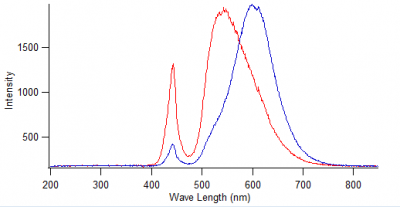Light Emission Range of the I phone
By Mohammad kanber
Nowadays, people rely completely on their phones for varieties of things, so we spend much of our time on our phones, which increases our exposure to these devices. Therefore, in this lab, the range of light emission of the iPhone is tested using Red Tid USB650 UV probe. To do this experiment, flashlight app from the apple store was downloaded. The uniqueness of this application is the ability to emit the highest light frequency that an iPhone can go to as well as the lower one. This can somehow measure the light emission capacity of the iPhone. the light source was placed in front of the Red Tid UV detector, which in turn can analyze the collected data and plot it as wave length vs Intensity as shown in Figure 1. The two graphs show two peaks with different frequency and wave length. The first one is at 450 nm, and corresponds to the violet blue color, which is a cold color. When light is very bright, the frequency of this peak decreases, and when the light is dim, the frequency of this peak increases. However, the other peak ranges from 530 to 605 nm depending on the brightness of the flash light, thus it corresponds to the yellow-orange colors. Notice that when the light is at the maximum brightness, the peak shifted from 530 nm to 605 nm. Therefore, the flash light emitted from the iPhone is still in the visible light spectrum, and higher brightness means the higher wave length.
Although wave length and energy are inversely proportional, it is not true to say that as wave length increases, the less energy consumption is because we do not live in a theoretical world. In fact, the intensity of the light does not really matter because when brightness is changed, the resistance of the circuit change, and this is where heat come to play in the orange and red region.
